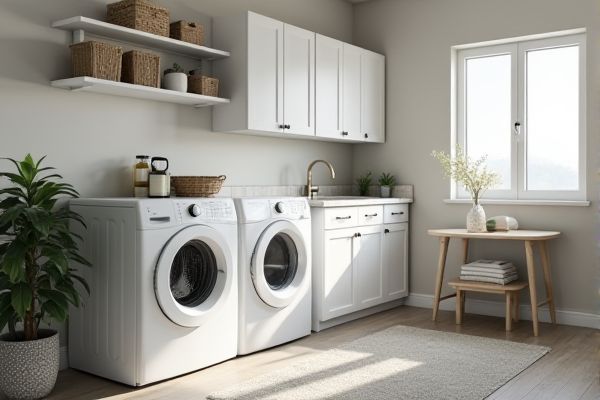
Water-resistant paint effectively prevents moisture penetration and mold growth, making it ideal for the humid environment of your laundry room compared to standard paint, which lacks these protective properties. Discover more about choosing the best paint to ensure your laundry area stays fresh and damage-free in the rest of this article.
Table of Comparison
| Feature | Water-Resistant Paint | Standard Paint |
|---|---|---|
| Moisture Protection | High resistance to moisture and humidity | Low moisture resistance; prone to damage |
| Mold & Mildew Resistance | Contains anti-microbial agents to prevent mold growth | No built-in mold or mildew protection |
| Durability in Laundry Room | Durable under frequent humidity and water splashes | Less durable; may peel or blister |
| Finish | Typically semi-gloss or satin for easy cleaning | Varies; often matte or eggshell |
| Cleaning | Easy to clean with wipes or mild detergent | Harder to clean; may stain |
| Cost | Higher price due to special formulation | More affordable |
| Ideal Use | Best for laundry rooms and high-humidity areas | Suitable for dry, low-traffic rooms |
Introduction to Laundry Room Paint Choices
Choosing the right paint for your laundry room is crucial due to the high humidity and frequent moisture exposure. Water-resistant paint offers enhanced protection against mold, mildew, and water damage compared to standard paint, making it ideal for damp environments. You should consider using water-resistant paint to ensure durability and maintain a fresh, clean appearance in your laundry room.
Understanding Water-Resistant Paint
Water-resistant paint contains special additives that repel moisture, making it ideal for high-humidity areas like laundry rooms. Unlike standard paint, it prevents water absorption and reduces mold and mildew growth, enhancing durability and maintaining your walls' appearance. Choosing water-resistant paint helps protect your laundry room from moisture-related damage and extends the lifespan of your paint job.
What Is Standard Paint?
Standard paint typically consists of a combination of pigments, binders, solvents, and additives designed for general interior or exterior use, offering basic protection and aesthetic appeal. It lacks specialized water-resistant properties, making it less suitable for high-moisture areas like laundry rooms where humidity and water exposure are frequent. Without a water-resistant formulation, standard paint can absorb moisture, leading to peeling, mold growth, and reduced durability in damp environments.
Moisture Challenges in Laundry Rooms
Laundry rooms face high moisture levels from frequent water use and humidity, making water-resistant paint essential to prevent mold, mildew, and peeling. Water-resistant paint features specialized polymers and additives that create a moisture barrier, unlike standard paint which absorbs moisture and deteriorates faster. Choosing water-resistant paint enhances durability and maintains wall integrity in the damp, humid environment typical of laundry rooms.
Key Differences: Water-Resistant vs. Standard Paint
Water-resistant paint offers superior protection against moisture, making it ideal for laundry rooms where humidity levels are high and water exposure is frequent. Standard paint lacks this moisture barrier, leading to potential peeling, mold growth, and damage in damp environments. Choosing water-resistant paint ensures your laundry room walls remain durable, mold-free, and visually appealing over time.
Durability and Longevity Comparison
Water-resistant paint in your laundry room offers superior durability compared to standard paint, resisting moisture, stains, and peeling caused by high humidity and frequent washing cycles. Standard paint tends to degrade faster under these conditions, leading to cracks and discoloration, which shortens its lifespan. Choosing water-resistant paint ensures longer-lasting protection and maintains the aesthetic quality of your walls in a moisture-prone environment.
Maintenance and Cleaning Ease
Water-resistant paint in your laundry room offers superior protection against moisture, making maintenance simpler by preventing mold and mildew buildup compared to standard paint. This type of paint withstands frequent cleaning with soap and water without peeling or fading, reducing the need for frequent touch-ups. Standard paint can absorb moisture, leading to stains and requiring more rigorous cleaning efforts to maintain its appearance.
Cost Implications: Investment vs. Value
Water-resistant paint for laundry rooms typically costs 20-40% more than standard paint but offers enhanced moisture protection that prevents mold and mildew damage, reducing long-term maintenance expenses. Investing in water-resistant paint increases upfront costs but provides significant value by extending wall durability and preserving the room's structural integrity. Standard paint may be cheaper initially but often leads to higher repair and repainting costs due to its lower resistance to humidity in laundry environments.
Aesthetic Considerations and Finish Options
Water-resistant paint offers a smoother, more durable finish ideal for high-moisture environments like laundry rooms, preventing peeling and discoloration often seen with standard paint. You can choose from matte, satin, or semi-gloss finishes that maintain vibrancy and resist mildew, unlike standard paint which may lose its aesthetic appeal quickly. Opting for water-resistant paint enhances both the look and longevity of your laundry room walls, ensuring a fresh, clean appearance.
Best Paint Recommendation for Laundry Rooms
Water-resistant paint is the best paint recommendation for laundry rooms due to its ability to withstand moisture, humidity, and frequent cleaning without peeling or fading. Standard paint lacks the protective qualities needed in damp environments, making it prone to mildew and damage over time. Choosing water-resistant paint ensures durability, maintains the aesthetic appeal of Your laundry room, and prevents costly repairs caused by moisture exposure.
 homyna.com
homyna.com